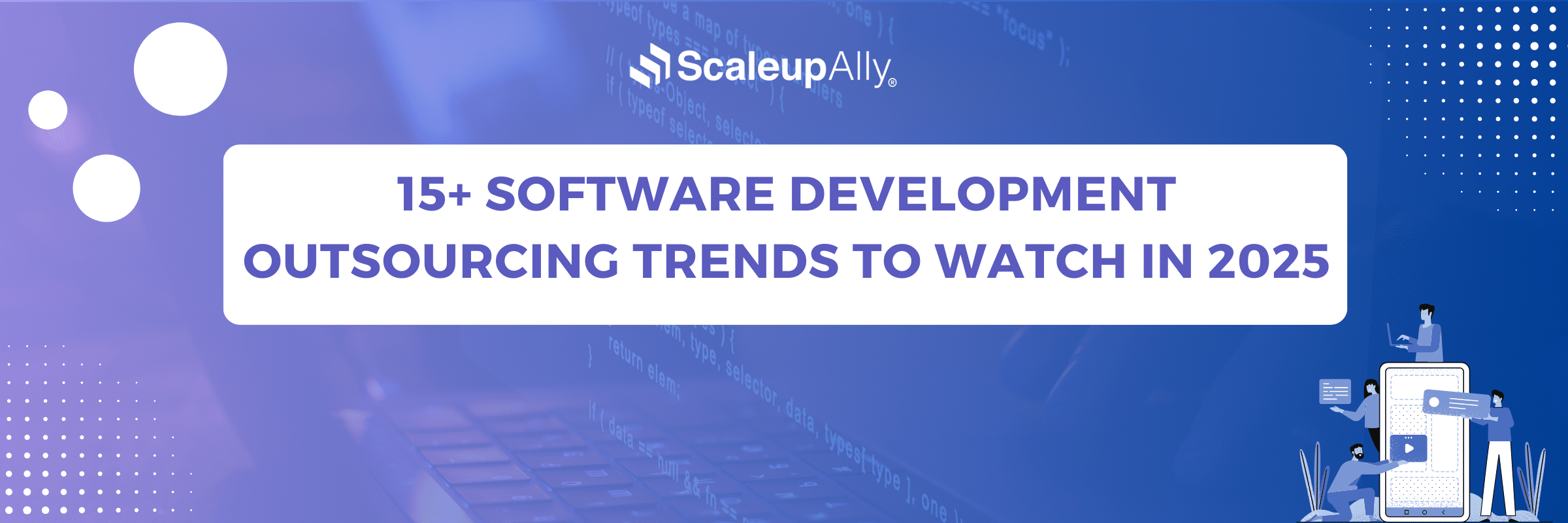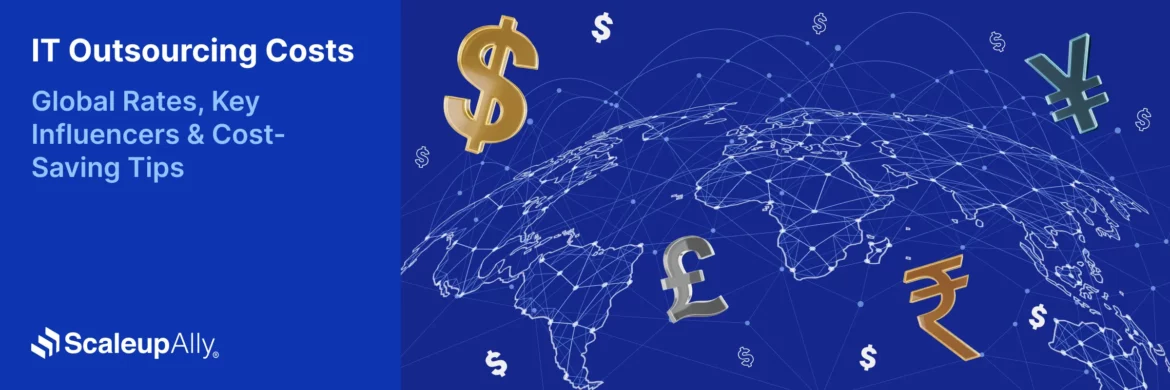
15 Software Development Outsourcing Trends to Watch in 2025
Pranay Agrawal | April 27, 2025 , 11 min read
Table Of Content
The days of “throw it over the wall” outsourcing are dead. The time of sending specifications to distant teams and hoping the result vaguely resembled what you envisioned is quietly fading away.
The pandemic forced successful experiments in remote work. This, among other factors, has permanently reshaped what companies expect from their software development partners. They’ve redefined what “good” looks like in outsourced software creation.
The software development outsourcing trends mentioned in this blog indicate we’ve entered a new chapter in the outsourcing story.
Let’s explore the forces reshaping software development outsourcing in 2025 and beyond.
Key Takeaways
- Companies now focus on value, prioritizing quality and expertise over just saving costs.
- Security and compliance are critical in outsourcing decisions due to rising data breaches and regulations.
- The shortage of specialized talent in areas like AI, blockchain, and quantum computing is driving businesses to seek expert outsourcing partners.
- New collaboration tools and remote work models are changing how outsourced teams work, making location less important.
- Sustainability and efficient coding are becoming important factors in choosing outsourcing partners.
Software Development Outsourcing Trends to Watch Out For
As software development continues to evolve, companies are on the lookout for the most cost-effective and time-efficient way of developing software. What proved efficient the previous year may already be outdated, making it essential to stay ahead of the curve.
Let’s look at the software development outsourcing trends for 2025 and beyond.
1. Prioritize value rather than price.
In the past, companies mainly outsourced to cut costs. 84% used to do it just to save money. But that’s changing.
Now, companies care more about the quality of their product than how cheap they can get it. 86% of leaders say getting good service is the most important thing when picking an outsourcing partner. And this makes sense because getting a product for cheap when it can’t perform its primary function would lead you to redevelopment, making that an added cost.
Today, companies weigh the perceived value of software outsourcing before fully investing. They care about expert teams, quicker results, and better software that brings more profit in the long run.
2. Increasing trend toward nearshore and onshore outsourcing
Outsourcing previously meant partnering with software development companies on another continent. But that’s also changing. Now, about 80% of North American companies are looking at outsourcing to nearby countries instead, because it’s easier to work with teams in the same time zones. There are also fewer cultural differences, which also means fewer misunderstandings. And if there’s a need for teams to meet in person, it’s faster and easier to travel.
Even though nearshore or onshore outsourcing locations may charge higher by the hour, it reduces the overall costs long term since communication is smoother, quality is often better, and there’s less time spent managing problems. COVID and supply chain issues made this even more important. Businesses want partners they can count on, especially in tough times.
3. Put cybersecurity at the forefront
The threat of cybercrime is growing fast. It’s expected to cost the world over $13 trillion by 2028, up almost 50% from 2024. And if a company suffers a data breach, it could cost almost $5 million on average, and many businesses don’t survive it.
For the above reasons, security is now a must when it comes to software development outsourcing. Companies want to know that their software development partners are handling their data safely, security compliant, and are fully prepared to deal with cyber threats instead of entirely focusing on the code only.
4. Specialized talent is in high demand
There’s a huge shortage in tech talent, and it’s only getting worse. By 2026, experts say 90% of companies will struggle to find the talent they need, which could cost businesses over $5.5 trillion in lost opportunities.
It’s most especially hard to find tech talent with specialized skills in areas like AI, blockchain, or quantum computing. Training people takes time, and hiring full-time experts isn’t always realistic, especially for short-term projects. This is why companies are outsourcing to find the right talent and not only to cut costs, as is mostly speculated. The focus is to find deep talent pools and up-to-date skills.
It is not surprising that many companies now work with multiple outsourcing vendors, each chosen for their specific knowledge, instead of relying on just one for everything.
5. India’s Growing Influence
India has been leading the offshore software development scene for decades, often offering cheaper and cost-cutting software development services, but that is changing fast.
Indian companies are now doing more advanced work in engineering, AI, and tech innovation. The outsourcing market in India is expected to grow from $64.6 billion in 2024 to over $99 billion by 2030.
Many Indian firms now have research labs, contribute to big tech projects, and understand how Western businesses operate. They’re helping drive innovation.
6. Business growth fueled by low-code development solutions
Low-code platforms (tools that help build apps with little or no coding) are growing fast. The market was worth $22.5 billion in 2022 and is expected to hit $32 billion in 2024. By 2025, 70% of apps built by companies will use low-code or no-code tools. That’s a big jump from just 25% in 2020!
Lowcode doesn’t mean developers won’t be in demand, but it just changes their role. Instead of writing tons of code, they focus more on setting up platforms, integrating different systems, and solving real business problems. That’s why companies now look for outsourcing teams that can blend tech skills with industry knowledge.
7. Focusing on Scalable Enterprise Solutions
Most software today, about 84 percent, is for large, enterprise-level systems. Companies no longer build basic applications anymore so they need sophisticated tools that can handle data, users, and transactions, all at the same time.
What this means is that companies need software development companies with experience building enterprise-level applications. These kinds of applications require deep knowledge of system design, scalability, and how different tools and platforms integrate. Smaller development teams often can’t keep up with these demands. So, many businesses are turning to larger, more experienced partners who know how to manage big projects from start to finish.
8. Strategic Outsourcing in the Financial Services Sector
72% of financial institutions now outsource their software development needs, and it makes sense. These companies deal with strict regulations, sensitive data, and outdated systems that still need to work with new tech. It’s a tough combo. So, they look for outsourcing partners who not only have strong tech skills but also understand regulations like PCI DSS, SOX, and GDPR.
Because it’s working well in finance, other industries with high security and compliance needs, like healthcare and government, are now following their lead.
9. Artificial Intelligence Adoption Becomes the Norm
AI is becoming a core component of software development. The AI software market is set to reach $391.43 billion by 2030, growing fast each year. More than 82% of development teams now use AI coding tools, which help developers write code faster and more efficiently. These tools boost productivity by around 37%, meaning outsourced teams can get more done in less time, without cutting corners on quality.
For businesses, this means faster delivery and more innovation. Teams using AI are getting products to market 40% quicker than those using old-school methods.
10. Embracing Remote-First Work Models
The pandemic normalised remote work. It got us off to a start, and now it’s about doing it better.
By 2027, over 80% of software development will happen in distributed teams using powerful collaboration tools (think more than just Zoom calls). These tools now include:
- Live coding together (pair programming)
- Virtual whiteboards that save your ideas
- AI meeting assistants that track what was decided and who’s doing what
And it’s working. Companies are happier with outsourcing partners who are great at this kind of remote teamwork.
11. Prioritizing Sustainability in Development
Sustainability in software development is now a must.
Data centers are expected to use 8% of all electricity by 2030. So, writing cleaner, more efficient code matters a lot.
Companies are now choosing outsourcing partners based on their green practices, like how they minimize energy use and build efficient systems. In fact, by 2028, most contracts will include rules about code efficiency and energy usage.
And it’s not just good for the planet, but good for business too. Energy-efficient apps can cut operating costs by 25% over their lifetime.
12. Developing Solutions for the Spatial Computing Age
We’re entering the spatial computing era (augmented reality (AR), virtual reality (VR), and mixed reality (MR)). A fast-growing tech with the market expected to hit $620.2 billion by 2032. But not enough developers know how to build these products for this technology. Only 8% of developers have solid experience in spatial computing, even though job listings for these skills jumped 143% in 2024.
To keep up, companies are turning to outsourcing. In fact, 67% of businesses working on AR/VR projects say they’re hiring external teams because they don’t have the right talent in-house.
And because these skills are in such high demand, outsourcing firms that specialize in spatial computing can charge 40–50% more than usual and still swamped with work.
13. Regulatory Compliance Proficiency
To build software today, one must stay compliant. With the EU’s Digital Services Act, China’s Personal Information Protection Law, and updates to GDPR, companies face a complex web of global regulations.
$2.25 billion in fines were handed out in 2023 alone for violations related to data privacy and compliance.
So, it’s no surprise that companies now see regulatory expertise as critical when choosing development partners.
14. Expanding Blockchain Applications Beyond Cryptocurrency
Crypto may dominate headlines, but enterprise blockchain is quietly becoming a major force. Global spending on blockchain solutions is expected to hit $19.9 billion by 2028, growing at 45.3% CAGR (IDC, 2024).
Neither Bitcoin nor NFTs are fuelling this growth, but practical business use cases. The challenge is that only 1% of developers worldwide have solid blockchain experience. So, most companies turn to outsourcing: 82% rely on external experts to get their blockchain projects off the ground.
Blockchain is no longer a nice-to-have. For many industries, it’s becoming a backbone for trust, transparency, and efficiency.
15. Embedded Finance Integration
Embedded finance (integrating payments, lending, and banking into non-financial apps) is transforming digital experiences. The global embedded finance market is projected to hit $83.32 billion by 2029, growing at 23.3% CAGR.
The surge is a result of consumers preferring transacting directly within the apps they already use, instead of switching to separate banking tools.
But seamless for users doesn’t mean simple for developers. According to McKinsey, adding embedded finance features extends project timelines by 34% when teams lack specialized expertise.
That’s why 68% of non-financial companies now outsource embedded finance development to partners with proven financial services integration skills. Understanding fintech infrastructure, compliance, and user flows is essential.
Conclusion
The right development partner can transform how your business delivers software today.
If you are ready to find that partner, our guide walks you through evaluating potential teams against these emerging trends.
Don’t let your competitors secure the best talent while you’re still figuring out where to look.
Read the full guide on How to Find The Best Software Development Partner.
Frequently Asked Questions
Q: What is the biggest software development outsourcing trend in 2025?
The shift from cost-focused to value-based outsourcing is the most significant trend. In 2025, outsourcing is all about value. Companies prioritize specialized expertise, quality and strategic impact. 86% of leaders now rank service quality above price when choosing development partners.
Q: How is AI impacting outsourced software development?
AI is revolutionizing outsourced development by boosting productivity by 37%, automating routine tasks, spotting bugs early and freeing up developers to focus on complex, creative problem-solving that adds real business value.
Q: Is outsourcing software development a good idea?
Outsourcing is effective when it matches your needs, offering access to specialized talent and faster development. Success hinges on selecting the right partner with the right expertise and ensuring clear communication from the outset.
Related Blogs

IT Outsourcing Costs Explained: Global Rates, Key Influencers & Cost-Saving Tips
Discover what IT outsourcing costs include, key pricing factors, hidden fees, regional rates, and how to pick a cost-effective outsourcing partner.
Pranay Agrawal
Nov 29 ,
13 min read

IT Consulting Rates Per Hour in 2025: Country & Industry Wise
Discover IT consulting rates broken down by experience, specialization, industry, and country. Plan your budget and find the right IT talent for your business needs.
Pranay Agrawal
Nov 25 ,
13 min read

Calculating ROI for Software Development: A Detailed Guide
Discover proven strategies and practical tips to enhance the ROI for software development projects. Learn how to measure success and increase profitability.
Manu Jain
Nov 25 ,
19 min read


